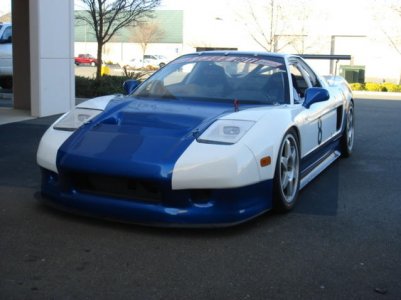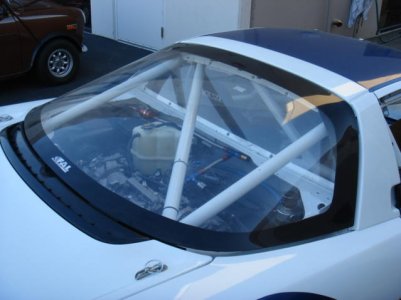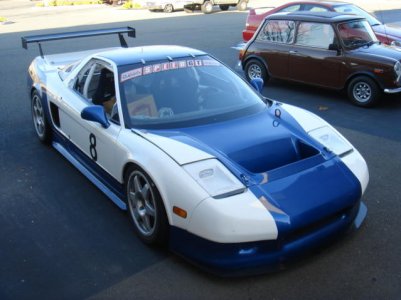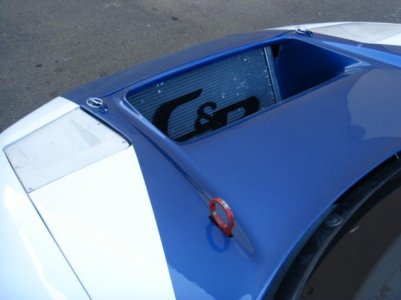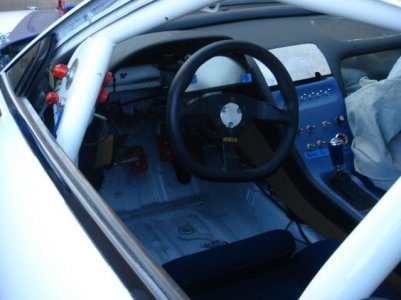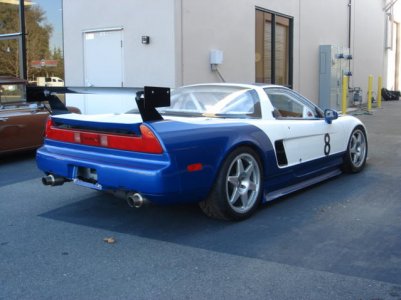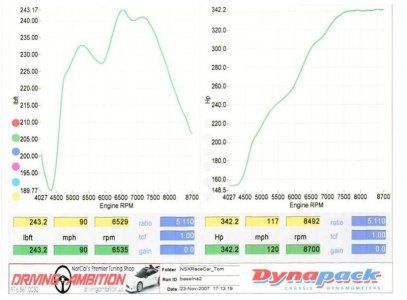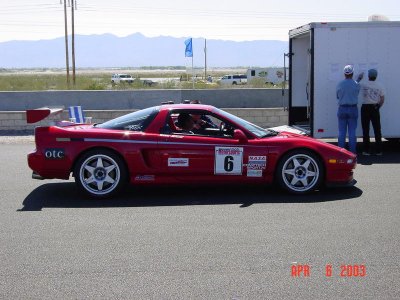Re: wowzers...
The engine is basically a CT camel-lights engine ...
In case you haven't seen it, here's the article on the Comptech Camel Lights car from the May 1994 issue of Car and Driver:
Warp Drive
How far can you go with an NSX V-6?
Real, real far, it turns out.
Being accredited graduates of The Oliver Twist Institute of
More, Please, our foray into things NSX naturally led us straight to the MGM Grand of Acuras: the Comptech Acura-Spice AK93 IMSA GTP Camel Lights race car. Which in turn led to a ride as memorable as an F-16 ejection.
At a glance, it may appear that the AK93 is to a production NSX what steak
au poivre is to a Wendy's single with cheese. But there are important similarities. For one thing, the AK93’s engine is based on the NSX's twin-cam, 24-valve 3.0-liter V-6 and uses many of the same parts. And the two cars share the same mid-engine/rear-drive layout and an undeniable
something in styling.
What's more, the Acura-Spice is one of the most successful racers of recent times. In 1991, the car's first full season, prime driver Parker Johnstone took the Acura-Spice to both the manufacturer's and driver's Camel Lights titles. He and the car then went on to repeat those feats in both 1992 and 1993. So this year, with the IMSA GTP series a memory and the AK93 destined for a museum in Japan, we thumbed a ride before this remarkable race car had its ignition cut forever.
In the metal, the AK93 is a "Speed Racer" cartoon come to life - low, flat, and even more Thierry Mugler than its stock sibling. The tape says the AK93 is more than a foot longer, almost three inches shorter in height, and more than seven inches wider. Yet it's a bantamweight. Due in part to its British-built Spice bodywork of Kevlar and carbon fiber, the AK93 is more than 1000 pounds lighter than the already-feathery aluminum-bodied NSX.
Calling the AK93 an "Acura" is no stretcher: the car's engine shares the NSX's basic aluminum block (a heavy-duty version is used in the race car), its alloy heads (the racer's are ported), and its titanium connecting rods. Features unique to the race engine include forged pistons, a boosted compression ratio (from 10.2:1 to 12.5), dual injectors per cylinder, and a dry-sump oil system.
While the race engine is a Honda design, it owes much of its success to the AK93's caretakers, Comptech Racing of EI Dorado Hills, California. Says Comptech team manager and co-founder Doug Peterson: "Honda R&D did all the initial development work in 1990, but since then we've handled all the rebuilds, the testing, and the ongoing improvements." The end result is a hulk without bulk: from just 3.0 naturally aspirated liters, the AK93's engine produces 440 horsepower at 8500 rpm, versus 270 at 7100 for the NSX engine. Torque rises from 210 pound-feet at 5300 rpm in the street car to 270 at 6000 in the racer.
All of which produced wondrous readings when we strapped on our Datron test gear. Geared for Willow Springs racetrack, the AK93 cracked off the kinds of numbers that make
more mavens salivate: 0 to 60 mph in 3.0 seconds flat, the quarter-mile in 11.0 seconds at 130 mph. And it circled the skidpad at a call-the-chiropractor 1.33 g.
Impressive as that g figure may be, running the AK93 in first gear around a 300-foot circle is a bit like trying to run the Kentucky Derby on a baseball diamond. That's because the car gets better with speed: at 150 mph, it generates 3800 pounds of downforce. Maximum racing grip, say Comptech's engineers, is more than 3.0 g's.
That we had to try. So we took the AK93 to Willow Springs racetrack to let Parker Johnstone open it up properly. Comptech graciously added a second seat, albeit one that seemed sized for Linda Hunt, so I could ride along.
As he will amiably admit, 32-year-old Johnstone - the winningest driver in IMSA history (and due to appear in IndyCars cars this season) - looks like Opie from Mayberry. Which is somehow disconcerting when together you are about to explore the limits of a machine as volatile as the AK93. Fortunately, Johnstone drives like Yeager flies.
After I was stuffed aboard (a task that required the help of three Comptech crewmen), Opie - er,
Parker - laid out the rules: "Hang on to the roll bar with both hands and don't let go. Do not let your feet touch the pedals or let your arms hit my arms. In fact, try not to touch me at all. If the car bursts into flames, pull
both release latches on your door." (I could not see either one.) And then we screamed out of the pits.
Now, nothing in my career had prepared me for what happened over the next five laps. The AK93 is not a car. It is an evil, organ-squashing, you're-just-a-lab-rat centrifuge. I had not seen physics defied like this since I took the S.A.T. test.
The circuit became not corners and straights but one continuous, furious, train-wreck-grade pummeling. We rocketed through 210-degree Turn Two at 130 mph and more than 2.0 g's. We braked for tight Turn Three so hard I thought my tongue was going to taste the windshield. We hammered toward sweeping, lethal Turn Eight, not slowing or braking but
accelerating - past 140 mph and up to 150 mph before clawing through Turn Nine at more than 2.5 g's.
Not touch Parker? It was all I could do to keep my cranium from fusing with his. And to think that in a race Johnstone does this for hours.
Words simply cannot describe the AK93 experience. Instead, we offer the following at-home exercises for a reasonable sensory facsimile:
Cornering: Lie on your side on a table, head extending over edge. Suspend 30-pound barbell disc from head. Strain to keep head level for three seconds. Rest for two seconds while shaking head vigorously. Switch sides. Repeat 40 times.
Braking: Perform 20-foot bungee jump, having replaced bungee cord with length of steel cable.
Suspension compliance: Have friend tow garbage-can lid down street. Ride lid.
General cockpit comfort: Squeeze into industrial washing machine. Select "Heavy Soil."
Then it was my tum to drive. Johnstone's advice: "The chassis is not very progressive when you reach the limit, so don't push too hard. The engine winds fast, so when the tach says 7500 rpm, start to shift and you'll be at 8500 when you finish. The car is very pitch-sensitive in fast comers, so don't lift off suddenly or you'll spin and crash. Oh, and have fun out there."
Actually, the AK93 was so fast I had no trouble driving it. That is, in five laps I couldn't get anywhere near its limits. In Tum Two, for instance, I was topping 110 mph and trying to hang onto the wheel and my liver was somewhere in my colon and
still I was 20 mph under Johnstone. When I hit the brakes for Turn Three it was like crashing into an oak tree - and
still I could have scored another first down with all the actual braking power left.
Strangely, it was hardest to get the car to obey me in the slow corners. "No downforce," smiled Johnstone later. "It's like we saw on the skidpad: no speed, no aerodynamics, no giant grip."
At its roots, the AK93 is quite refined. Its engine is very smooth and tractable and makes nice, deep, growly noises as it revs. The Hewland five-speed is light and easy to shift. The four-piston Brembo brakes have surprisingly good feel for their power. And the view outside is exemplary - even in the tiny rearview mirrors. But when I asked the AK93 to do car things - go, stop, turn - it did them so ferociously that in only five laps I was as sore as if I'd just tried to take a picture of Sean Penn.
Definitely
more NSX. More bruises, too.
- Arthur St. Antoine
Vehicle type: mid-engine, rear-wheel-drive, 1-passenger, 2-door race car
Price as tested: $300,000 (estimated)
Engine type: DOHC 24-valve V-6, aluminum block and heads, EFI Technologies engine-control system with port fuel injection
Displacement … 182 cu in, 2977cc
Power (SAE net) … 440 bhp @ 8500 rpm
Transmission … 5-speed
Wheelbase … 105.0 in
Length … 189.0 in
Curb weight … 2015 lb
Zero to 60 mph … 3.0 sec
Zero to 100 mph … 6.3 sec
Zero to 130 mph … 11.0 sec
Standing 1/4 –mile … 11.0 sec @ 130 mph
Top speed (redline limited) … 150 mph
Braking, 70-0 mph … 125 ft
Roadholding, 300-ft-dia skidpad … 1.33 g
Typical racing fuel economy (racing gasoline) … 5 mpg


